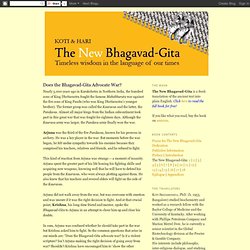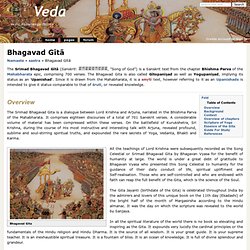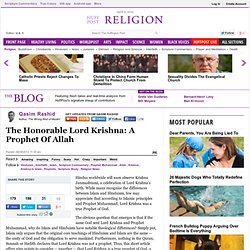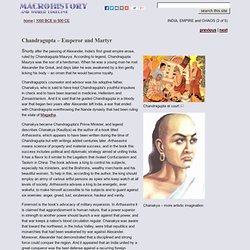

Philosophy East and West, Vol. 19, No. 2 (Apr., 1969), pp. 159-169. The Bhagavad Gita. Does the Bhagavad-Gita Advocate War? Nearly 5,000 years ago in Kurukshetra in Northern India, the hundred sons of King Dhritarastra fought the famous Mahabharata war against the five sons of King Pandu (who was King Dhritarastra’s younger brother).

The former group was called the Kauravas and the latter, the Pandavas. Almost all major kings from the Indian subcontinent took part in this great war that was fought for eighteen days. Although the Kaurava army was larger, the Pandava army finally won the war. Arjuna was the third of the five Pandavas, known for his prowess in archery. He was a key player in the war. This kind of reaction from Arjuna was strange -- a moment of insanity.
Arjuna did not walk away from the war, but was overcome with emotion and was unsure if it was the right decision to fight. In sum, Arjuna was confused whether he should take part in the war but Krishna asked him to fight. If we dig deeper into the context of the Mahabharata war, we will find satisfactory answers to our questions. Peace had lost. Heart of Hinduism: Atman. Key Points The real self (atman) is distinct from the temporary body.

Material designations do not apply to this eternal soul. The atman is spirit (brahman) – unchanging, eternal and conscious. Consciousness, as spread throughout the body, is a symptom of the soul. In order to understand the Hindu worldview it is essential to grasp this first and foundational concept. Ideas of reincarnation are natural extensions of this preliminary concept. A Useful Analogy: The Driver in the Vehicle. Bhagavad Gītā. The Srimad Bhagavad Gītā (Sanskrit: भगवद्गीता, "Song of God") is a Sanskrit text from the chapter Bhishma Parva of the Mahabharata epic, comprising 700 verses.

The Bhagavad Gita is also called Gītopaniṣad as well as Yogupaniṣad, implying its status as an 'Upanishad'. Since it is drawn from the Mahabharata, it is a smṛti text, however referring to it as an Upanishads is intended to give it status comparable to that of śruti, or revealed knowledge. The Srimad Bhagavad Gita is a dialogue between Lord Krishna and Arjuna, narrated in the Bhishma Parva of the Mahabharata. It comprises eighteen discourses of a total of 701 Sanskrit verses. A considerable volume of material has been compressed within these verses. Merry Krishna-mas! Indians celebrate Krishna's birthday.
Qasim Rashid: The Honorable Lord Krishna: A Prophet Of Allah. Hindus worldwide will soon observe Krishna Janmashtami, a celebration of Lord Krishna's birth.

While many recognize the differences between Islam and Hinduism, few may appreciate that according to Islamic principles and Prophet Muhammad, Lord Krishna was a true Prophet of God. The obvious question that emerges is that if the same God sent Lord Krishna and Prophet Muhammad, why do Islam and Hinduism have notable theological differences? The Maurya Empire and a Dark Age. Macrohistory.com (INDIA, EMPIRE and CHAOS – continued) Shortly after the passing of Alexander, India's first great empire arose, ruled by Chandragupta Maurya.

According to legend, Chandragupta Maurya was the son of a herdsman. When he was a young man he met Alexander the Great, and days later he was awakened by a lion gently licking his body – an omen that he would become royalty. Chandragupta's counselor and advisor was his adoptive father, Chanakya, who is said to have kept Chandragupta's youthful impulses in check and to have been learned in medicine, Hellenism and Zoroastrianism. Chanakya became Chandragupta's Prime Minister, and legend describes Chanakya (Kautilya) as the author of a book titled Arthasastra, which appears to have been written during the time of Chandragupta but with writings added centuries later. Foremost is the book's advocacy of military expansion. Chandragupta as Autocrat, Sensualist and Martyr But there was no attempt at nation building.
Sources. The Laws of Manu I. Sacred Texts Index Hinduism Index Laws of Manu Index Next 1.

The great sages approached Manu, who was seated with a collected mind, and, having duly worshipped him, spoke as follows: 2. 'Deign, divine one, to declare to us precisely and in due order the sacred laws of each of the (four chief) castes (varna) and of the intermediate ones. 3. 4. Jnana Yoga. Christ and Krishna - the Name is the Same. Vijaya Dashami. Festival of Dasara Vijaya Dashami also known as Dasara, Dashahara, Navaratri, Durgotdsav… is one of the very important & fascinating festivals of India, which is celebrated in the lunar month of Ashwin (usually in September or October) from the Shukla Paksha Pratipada (the next of the New moon day of Bhadrapada) to the Dashami or the tenth day of Ashwin.

This festival is celebrated not only in India but in almost all eastern countries like Java, Sumatra, Japan etc... Dasara is Nepal’s national festival. Word DASARA is derived from Sanskrit words “Dasha” & “hara” meaning removing the ten (10).